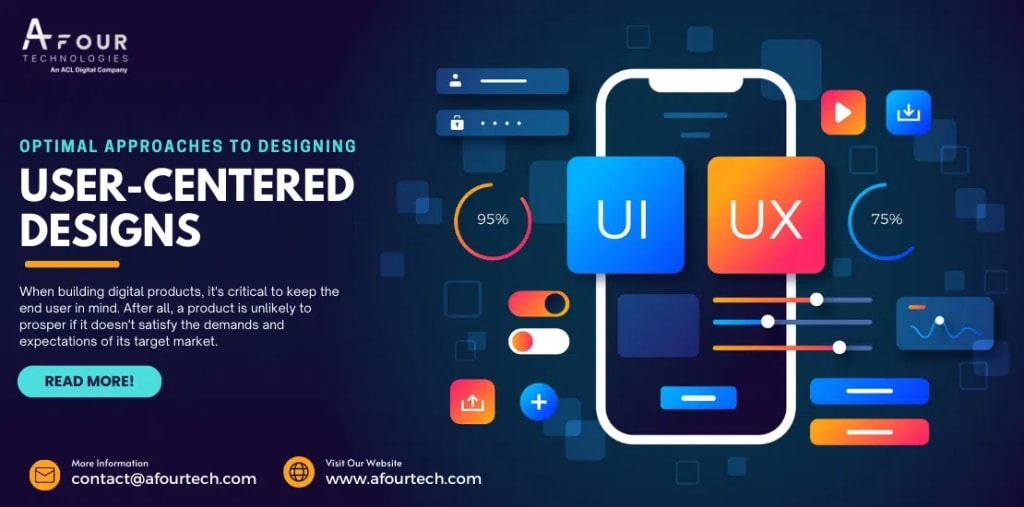
When building digital products, it’s critical to keep the end user in mind. After all, a product is unlikely to prosper if it doesn’t satisfy the demands and expectations of its target market. This is where user-centered design comes in – a design approach that places the user at the core of the entire product design process.
This blog post will look at the best methods for creating user-centered designs. We’ll talk about user-centered design, why it’s crucial, and how it’s made. We’ll also review fundamental principles for developing strategies that satisfy end users’ needs.
So, whether you’re a seasoned designer or just starting, this post will provide valuable insights and practical tips for creating products that resonate with your target audience, especially if you’re working in a custom software development company. So without any further ado, let’s dive in!
What is User-Centered Design?
User-centered design (UCD) is an iterative design technique that focuses on the wants and preferences of end-users throughout the product design and development lifecycle. It involves fully understanding the user’s goals, tasks, and contexts of use to build products that are intuitive, beneficial, easily accessible, and delightful to use. In today’s digital landscape, where people have high expectations of the goods they use, UCD is becoming increasingly pertinent. By prioritizing the user’s needs and preferences, UCD can help create products that are functional and easy to use.
Importance of User-Centered Design
User-centered design (UCD) is critical to the success of any product or service. Not using or optimizing it properly can cost you time and effort and significantly influence a system’s success or failure. Here are some reasons why it’s so important!
1. Improves User Experience: By focusing on the user’s needs and preferences, UCD creates more intuitive and useful products. This improves the overall user experience, leading to higher customer satisfaction and retention.
2. Increases Engagement: A product that is simple and pleasant to use is more likely to engage users, resulting in more adoption and greater levels of engagement. This is especially true for digital products, where user engagement is a critical success metric.
3. Reduces Costs: UCD can assist in identifying and addressing usability issues early in the design phase, decreasing the expense of repairing them later. This may reduce costs and make the design process run more smoothly.
4. Enhances Brand Image: A product built with the user in mind demonstrates that the company cares about its consumers and is dedicated to offering a great user experience. This may improve the company’s reputation and brand image.
5. Increases Market Share: UCD can provide a competitive edge to firms by generating more user-friendly and appealing products than competitors’ offerings, resulting in increased market share and revenue.
User-Centered Design Process
The UCD process is iterative, meaning one stage informs and impacts the next. And it mainly involves several steps, each with its own activities and goals.
1. Research: Research is the initial step in the UCD process. In this phase, designers learn about the user’s needs, preferences, and behaviours. This can be accomplished using various techniques, including surveys, interviews, and observation.
2. Analysis: After completing the research, designers analyze the data to uncover patterns and themes. This lets them better grasp the user’s goals, tasks, and usage scenarios.
3. Design: Based on the insights from the research and analysis stages, designers create design concepts that meet the user’s needs and preferences. This can involve creating wireframes, prototypes, and other design artifacts.
4. Evaluation: The design concepts are tested with real people to obtain input and discover usability difficulties. This can be accomplished using focus groups, surveys, and usability testing techniques.
5. Refinement: Based on the feedback from user testing, designers refine the design concepts to improve usability and address any identified issues.
6. Implementation: Once the design is finalized, it is implemented and launched to the market. It’s important to continue gathering feedback and improving the product over time.
User-Centered Design Key Principles
User-centered design (UCD) is a design approach that prioritizes the needs and preferences of the end-users throughout the design process. To ensure the success of UCD, designers should adhere to several key principles, including but not limited to:
1. A thorough understanding of Users and their needs: Designers must have an in-depth knowledge of their wants, preferences, and behaviours to build products that match their expectations. This requires extensive research and analysis to get insights into the user’s goals, tasks, and usage situations. The key driving factor behind the user-centered design is understanding the user and how they will interact with the product.
2. Early and frequent involvement of users: Users should be involved in the design process from the start and at every stage because it helps stakeholders understand their target users and what solutions they should be building. This can avoid subsequent, expensive redesigns and ensures that the client’s wants and preferences are considered during the pre-design talks.
3. Incorporating user feedback to define requirements and design: Incorporating user feedback to determine criteria and design is a crucial principle of user-centered design. By actively soliciting input, designers can acquire insights into their users’ requirements, preferences, and behaviours. This input can then be utilized to guide the design process and guarantee that the finished product lives up to user expectations.
4. Maintaining Consistency: Consistency is essential for developing a simple product to use and understand. A product that employs these procedures will be dynamic for the user to interact with while reducing unnecessary cognitive effort. Designers must ensure that the product’s layout, language, and functionality are consistent.
5. Provide adequate feedback and intuitive navigation: A competent designer can anticipate where a user might get hung up or stuck when using their product. This is why providing enough input and assistance throughout the product development cycle guarantees that users understand what is happening and what they need to accomplish. The product should also have simple navigation so that people can quickly discover what they need.
6. Utilize an iterative design process: Iterative processes are used in User Centric Design, meaning each step guides and affects the next. Designers can create a product that meets the user’s needs and preferences by continuously gathering feedback, making improvements, and informing subsequent upgrades.
Wrapping Up
In conclusion, developing user-centered designs is crucial for creating a delightful user experience for any business. However, designing a UI/UX that meets users’ needs and preferences can be challenging, and that’s where expert UI UX development services come into play.
By partnering with a reputable cybersecurity consultant like AFour Technologies, businesses can create aesthetically pleasing but also intuitive and user-friendly designs.
With AFour Tech’s efficient UI UX Design and Development Services, businesses can create a design that aligns with their customer’s expectations and delivers high value most innovatively and cost-effectively. For more information, please get in touch with us at [email protected] to book your free consultation today.
About the Creator
Afourtech
AFour Technologies is a software development services, ISO certified company, offers Product Engineering Services with in Data Center Technologies IoT






Comments
There are no comments for this story
Be the first to respond and start the conversation.